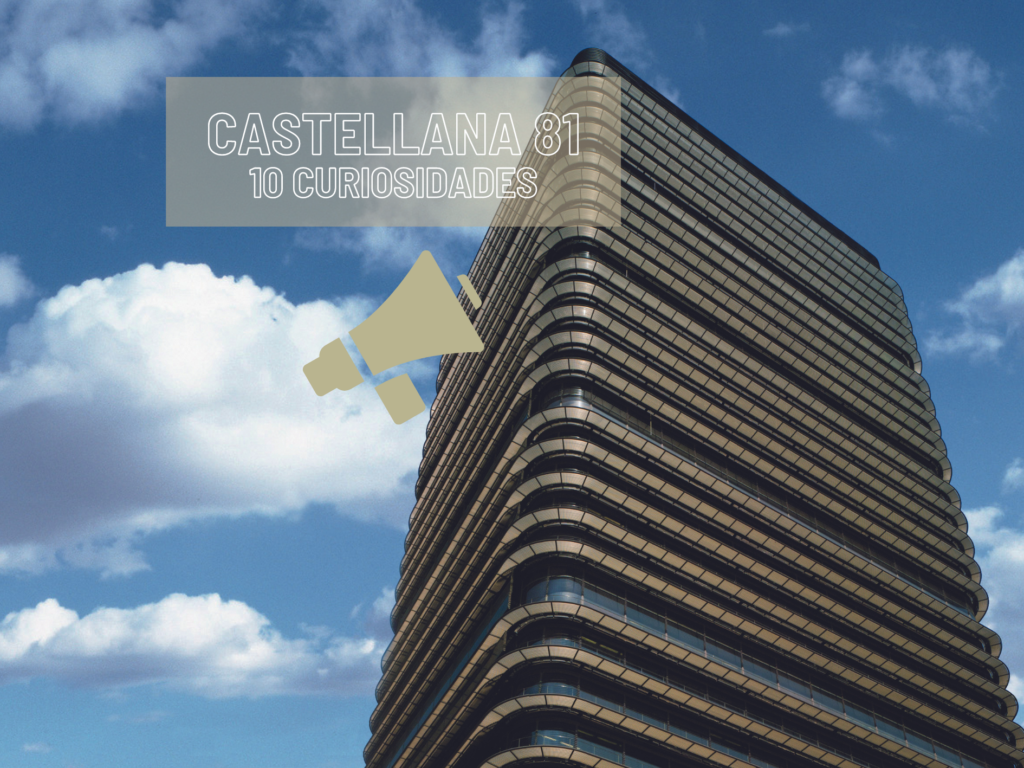Castellana 81: 10 interesting curiosities about the Tower
The Castellana 81 Tower is one of the most emblematic buildings in Madrid’s skyline. This skyscraper located in the financial heart of the city, in AZCA, has a history and characteristics that make it truly unique.
Here are ten interesting facts about this impressive tower that you probably didn’t know until today.
1. Design signed by a Master.
The Tower was designed by the renowned architect Francisco Javier Sáenz de Oiza. His innovative vision and his focus on functionality and aesthetics have left an indelible mark on architecture with this work. The Tower features the architect’s ‘signature’ on one of its revolving doors.
2. Construction and height.
It was inaugurated in 1981, has a height of 107 metres and 28 floors of which 5 are double height. For many years, it was one of the tallest buildings in Madrid.
3. Unique façade.
The general composition of the façade responds to the criterion of combining a totally glazed surface, with very solid carpentry, made of ‘Cortén’ steel, reinforced with a series of horizontal lines that underline the interior organisation and the uninterrupted character of the floors, without any vertical structure whatsoever.
Cortén steel is a material that oxidises on the outside to protect its own interior, giving the façade a very singular chromatism and texture that evolves with the passage of time and distances it from the coldness of unalterable materials. Sáenz de Oiza was a pioneer in its use in architecture.
4. Glass panels.
It is composed of tinted glass panels and anodised aluminium, which gives it a sophisticated and contemporary look. In addition, these materials help to regulate the interior temperature and optimise the building’s energy efficiency.
5. Built on railway tracks.
One of the most impressive curiosities of Castellana 81 is that it was built on the train tracks of the Nuevos Ministerios station. This represented a great technical and engineering challenge, which was overcome thanks to innovative solutions that allowed the structure to coexist with the railway infrastructure without affecting the train service.
6. Comprehensive renovation.
Between 2015 and 2017 it underwent a thorough renovation. The project, led by architect Ruiz Barbarín, modernised the facilities, improved energy efficiency and restored original elements of Sáenz de Oiza’s design.
7. Declared an Asset of Cultural Interest.
The Governing Council of the Community of Madrid declared Castellana 81 an Asset of Cultural Interest (BIC), in the Monument category. This is the first time that such a recent construction has obtained protection as a BIC in the Community of Madrid.
8. Sustainability, health and wellbeing.
Castellana 81 is a benchmark for sustainability in the Madrid skyline. It was the first office building on Paseo de la Castellana to achieve LEED Platinum Core & Shell Certification, the maximum possible under the LEED certification system awarded by the US Green Building Council (USGBC). It was also the first WELL office building in Spain and the fifth in Europe to obtain WELL Building Standard Gold certification in the Core & Shell category.
9. Smartbuilding.
A pioneering office building in digital experience and connectivity, it was the first BIC building to obtain the WiredScore and SmartScore certifications, achieving the highest level of these international standards: Platinum. This achievement strengthened its commitment to innovation, sustainability and its people-oriented design.
10. Sculpture ‘Isabella’ by Jaume Plensa.
At the entrance of Castellana 81 is the impressive sculpture ‘Isabella’ by the renowned Spanish artist Jaume Plensa. This piece of contemporary art, depicting a human head in a meditative pose, has become a visual icon of the building and adds a touch of elegance and reflection to the business environment.
In summary, Castellana 81 is not only a symbol of Madrid’s financial and business development, but also an architectural landmark. Its presence in the city skyline is a reminder of the continuous growth and modernisation of the Spanish capital.









